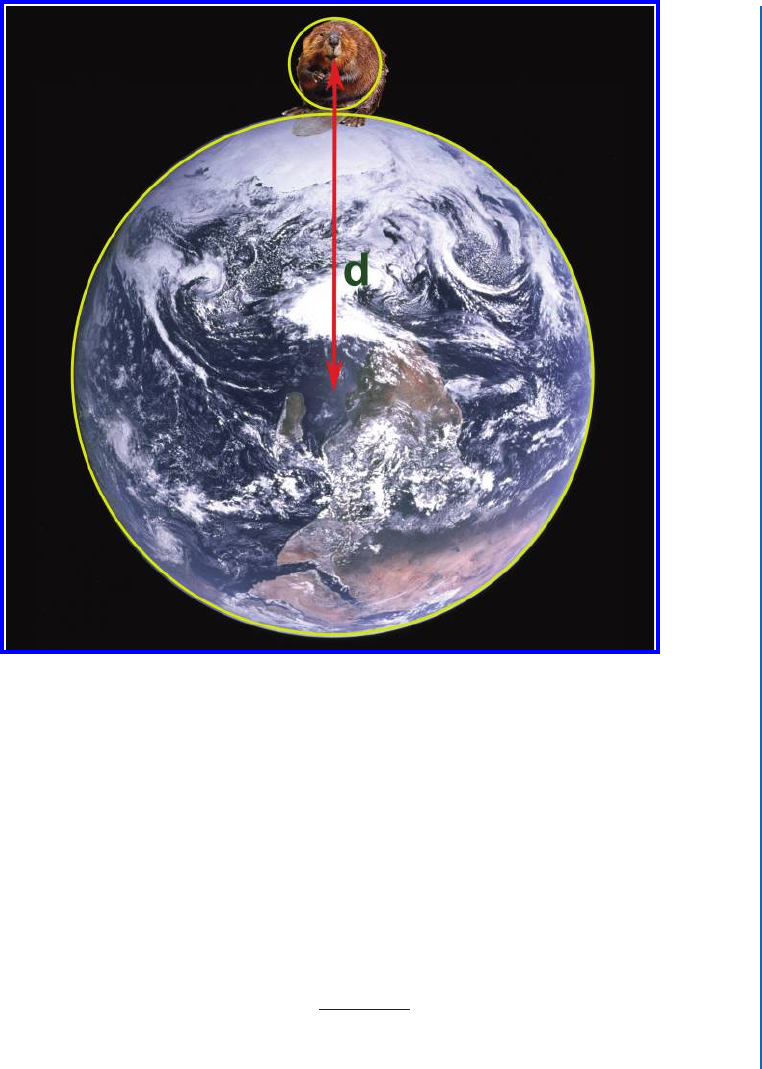
145
C H A P T E R 11
Fields
11.1 NEWTON’S GRAVITY
e Law of Universal Gravitation, formulated by Isaac Newton in the late 17th century, was the
first description of a universal physical law in the modern sense. It built upon the foundation of
Galileo and Kepler, a generation before.
Newtonian gravitation has as its foundation the notion that every point of mass in the
universe experiences an attractive force toward every other point of mass. is force, F
G
, has
a strength that is proportional to the product of the two masses, and inversely proportional to
the square of the distance between them. An intrinsic symmetry is apparent: each mass feels the
same force toward the other. But since the force is attractive, this means these two forces are
opposite in direction; it is a mutual attraction.
If we denote the two masses as m
1
and m
2
, and the distance between them as d , we can
write this law as follows:
F
G
D G
m
1
m
2
d
2
: (11.1)
Here G represents a constant of proportionality, the value of which depends upon the details
of our particular system of units of measurement, combined with the quantitative strength of
gravity. In our SI system of units, we measure the masses in kilograms (kg), the distance in
meters (m), and the force in Newtons (N).
1
And so the numerical value of G represents the force
of gravity in Newtons between two 1-kg masses placed one meter distant from each other.
We can solve Equation (11.1) for
G
:
G D
d
2
F
G
m
1
m
2
: (11.2)
And so to measure G we need only place two 1-kg masses 1 m apart, and then measure the
gravitational force each feels toward the other. Newton did not perform this obvious experi-
ment, because it is equally obvious that this force must be extremely small—far too small to be
measured in Newton’s time. Otherwise, our world would be a very different place; the stuff of
our everyday existence would want to gravitate together into one lump. e constant of universal
gravitation, G, was first measured in the late 1700s—some seven decades after Isaac Newton’s
death—by Henry Cavendish, using a sensitive torsion balance. Modern measurements yield G
1
A kilogram of mass here on the surface of Earth weighs about 9.8 N.

146 11. FIELDS
Figure 11.1: An illustration of the torsion balance used by Henry Cavendish to measure the
constant of universal gravitation. (Graphic Public Domain.)
to be a tiny quantity indeed:
G D 6:674 ˆ 10
´11
N m
2
kg
´2
: (11.3)
See Figure 11.1 for an illustration of Cavendish’s apparatus.
e very small measured value for G means that gravitation is a relatively weak force,
measurable on our everyday scale only with the most sensitive of instruments. Electrical forces,
for example, are overwhelmingly larger, all else being equal. e gravitational force between two
1-kg masses placed one meter apart is only 6:674 ˆ 10
´11
N, equivalent to the weight here on
Earth’s surface of a microscopic droplet of water only 0.024 mm (24 m) across. is is about
the weight of a microscopic protozoan such as Trypanosoma cruzi (which causes Chagas disease)
or Entamoeba histolytica.
Gravity is the force that most concerns us as citizens of Earth. But this is only because we
happen to be relatively close to an enormous quantity of mass—the 5:972 ˆ 10
24
kg of mostly
rock and metal that makes up Earth. For astronomers, it is gravity that holds it all together
and has the greatest effect on the motions of large bodies in the universe, even though it is the
intrinsically weakest of the physical forces, all else being equal. e reason is that all else is not
equal; gravitation is the only one of the fundamental forces that is both long-range and only
attractive. e much-stronger electrical force, for example, can either attract or repel, and so it
tends to cancel out at large distances.

11.1. NEWTON’S GRAVITY 147
11.1.1 THE CLASSICAL GRAVITATIONAL FIELD
Equation (11.1), taken at face value, asserts that one object exerts an instantaneous influence (a
gravitational force) upon another, even if the two are separated by a vast expanse of the vacuum
of space. But it is possible to look at Newton’s gravity in a different way; we replace the action
at a distance with the local action of the gravitational field.
Let us return to our example of two point masses, m
1
and m
2
, placed a distance d from
each other. From the point of view of Newton, we say that m
1
exerts a gravitational force, at
a distance, on m
2
. But from the perspective of the gravitational field, we say something subtly
different: the presence of m
1
causes there to be a gravitational field, Eg, that extends throughout space.
We can think of this field as a property of space itself. And so we have the gravitational field,
Eg, due to the presence of m
1
. Our field theory must then tell us how to calculate this field. For
this simple case of the gravitational field due to a single point mass, the answer is very simple.
e field points everywhere toward m
1
, and it has this magnitude, for a point in space located a
distance d from m
1
:
g D G
m
1
d
2
: (11.4)
But this is only half the story; we must also say what the field does. And the answer to this is
even simpler:
e gravitational field, Eg, at a given point in space exerts a force on any mass, m, that
is placed there. And that force is given by
E
F
G
D mEg. e gravitational field thus has
dimensions of force per unit mass (SI units of N kg
´1
).
e little arrows are there to remind us that both the gravitational field and the gravitational
force are in the same direction.
We can now consider what happens to m
2
from the perspective of the gravitational field.
e mass m
2
knows nothing about m
1
; it only knows that locally—where it is—there is a grav-
itational field, Eg. is local gravitational field exerts a gravitational force on m
2
in the direction
of Eg, and with magnitude F
G
D m
2
g. But we have already seen that Eg points toward m
1
, and so
too does
E
F
G
. And we also know the magnitude of Eg from Equation (11.4). us, we have
F
g
D G
m
1
d
2
m
2
: (11.5)
e result is the same as what we already knew; m
2
experiences a force toward m
1
, and given by
Equation (11.1).
If the local field conception of a gravitational field always produces the same result as
Newton’s original action-at-a-distance, then why bother with fields at all? Let us consider a
different example. Suppose that we attach some kind of meter to m
2
that allows us to directly
measure the gravitational force acting upon it. And then suppose we quickly move m
1
a bit closer
to m
2
, thus making d smaller. Obviously, the force meter would then read a higher value; both
the action-at-a-distance and local-field conceptions agree.
148 11. FIELDS
But does the increase in F
G
occur instantaneously? Or is there some sort of time delay? If
gravity acts instantaneously at a distance, it means we could use the gravitational force to send
messages across the vastness of space, with no time delay at all. Clearly, this would violate special
relativity, which implies that no influence can travel faster than light (see Section 5.1).
Newton’s action-at-a-distance conception of gravity implies, in effect, that the gravita-
tional interaction acts instantly, no matter the distance of space. Considering gravity instead as
the local action of a field provides a way out of this dilemma. For we could imagine that the
when we move m
1
, the resulting change in the gravitational field—a property of space itself—
propagates outward from m
1
at a finite speed in some kind of wavelike disturbance. Object m
2
would then react only when that disturbance in the gravitational field reached its location. is
basic concept is called a gravitational wave, and there is no possibility for such a phenomenon
in Newton’s theory of gravity. If we were to attempt to modify Newtonian gravity so as to allow
for gravitational waves, a field-theory perspective would be essential.
Einstein’s theory of gravity, completed a decade after his published paper on special rel-
ativity, is a field theory. But it is not a force field like our field-theory formulation of Newton’s
gravity. Rather, Einstein’s gravitational field is the effect matter has on the very geometry of
space and time itself. We consider Einstein’s theory of gravity more fully in Section 11.2.
11.1.2 GRAVITY AND SPHERES
Much of the motivation for the Cavendish experiment was not directly to measure the constant
of proportionality, G, in Newton’s law of gravity. Rather, Cavendish wanted to measure the mass
(more specifically the density) of Earth. What is the connection? Consider Figure 11.2.
A small object of known mass—a beaver
2
in this example—sits on the surface of Earth.
It experiences the downward force of gravity we call weight, easily measurable with a balance
or scales. is “downward” force is, by observation, toward the center of Earth. is should be
unsurprising; the symmetry of the law of gravity and the arrangement of masses dictates that
this is the only possible direction. But what is the magnitude of this force? Equation (11.1), in
and of itself, does not provide the answer, for it applies to two point-like masses.
To apply Equation (11.1) to this example, one would need to break Earth up into little
tiny pieces, each of which is small enough to be considered point-like. en the law of gravity
could be applied to each piece with Chapter 2—noting that even if the masses are chosen to be
equal, the distances are not. But also, one would need to take the quite-different directions of
these myriad tiny forces into account when adding them up. is process—breaking a problem
up into tiny pieces, calculating something for each piece, and then adding up all of the results—
is part of the foundation of calculus. ese mathematical techniques did not exit in Newton’s
day, so he had to invent them. We now call it integration. For this particular case, although the
process is complex, the answer is simple:
2
Not drawn to scale.

11.1. NEWTON’S GRAVITY 149
Figure 11.2: e gravitational force between two spheres acts as if all of the mass of each sphere
were concentrated at its center. (Earth image: NASA/Apollo 17 crew, Public Domain. Beaver
image by Steve, Washington, D.C., CC BY-SA 2.0.)
e gravitational force between spherically symmetric distributions of mass acts as if
all of the mass were concentrated at their centers.
With this mathematical result, the way forward is clear; the force between the beaver and Earth
can be calculated with Equation (11.1). We simply use for d the distance between the center of
the beaver
3
and the center of Earth. If we assume this is not actually a giant space beaver, and so
it is minuscule compared to Earth, then this distance is, essentially, the radius of Earth. us,
we have:
F
G
D G
m
beaver
M
C
R
2
C
: (11.6)
3
Assume a spherical beaver.
..................Content has been hidden....................
You can't read the all page of ebook, please click here login for view all page.
